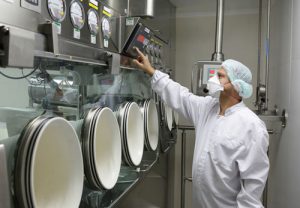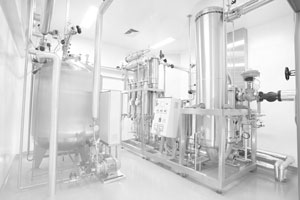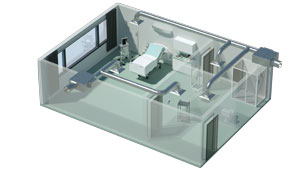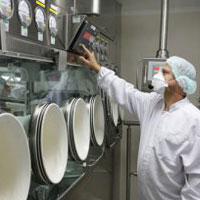 Thermal flowmeters use the thermal properties of the fluid to measure the flow of a fluid flowing in a pipe or duct. In a typical thermal flowmeter, a measured amount of heat is applied to the heater of the sensor. Some of this heat is lost to the flowing fluid. As flow increases, more heat is lost. The amount of heat lost is sensed using temperature measurement(s) in the sensor. The transmitter uses the heat input and temperature measurements to determine fluid flow. Most thermal flowmeters are used to measure gas flows. Thermal flowmeters represent 2% of global flowmeter sales. Continue reading “How Thermal Flowmeters Work”
Thermal flowmeters use the thermal properties of the fluid to measure the flow of a fluid flowing in a pipe or duct. In a typical thermal flowmeter, a measured amount of heat is applied to the heater of the sensor. Some of this heat is lost to the flowing fluid. As flow increases, more heat is lost. The amount of heat lost is sensed using temperature measurement(s) in the sensor. The transmitter uses the heat input and temperature measurements to determine fluid flow. Most thermal flowmeters are used to measure gas flows. Thermal flowmeters represent 2% of global flowmeter sales. Continue reading “How Thermal Flowmeters Work”
The Operation of Gages and Switches in Hazardous Environments
In many industrial processes, the materials and the end product or by-products  of the process, such as dust or vapors, can create conditions for a hazardous environment. Processes that have potential for hazardous environments include: water treatment, oil drilling, gas and chemical processing, power generation, pharmaceutical, and food manufacturing. The measurement and control of these processes are essential in maintaining optimal conditions of the manufacturing system and preventing catastrophic events. Continue reading “The Operation of Gages and Switches in Hazardous Environments”
of the process, such as dust or vapors, can create conditions for a hazardous environment. Processes that have potential for hazardous environments include: water treatment, oil drilling, gas and chemical processing, power generation, pharmaceutical, and food manufacturing. The measurement and control of these processes are essential in maintaining optimal conditions of the manufacturing system and preventing catastrophic events. Continue reading “The Operation of Gages and Switches in Hazardous Environments”
[New Product Highlight] StabiliSENSE™ Critical Room Pressure Monitor | Series RPMC
 The Dwyer team recently released the StabiliSENSE™ critical room pressure monitor, Series RPMC. This series is ideal for critical low differential room pressure applications, such as: clean manufacturing areas, semiconductor manufacturing, pharmaceutical, clean rooms, research labs, and vivariums. Continue reading “[New Product Highlight] StabiliSENSE™ Critical Room Pressure Monitor | Series RPMC”
The Dwyer team recently released the StabiliSENSE™ critical room pressure monitor, Series RPMC. This series is ideal for critical low differential room pressure applications, such as: clean manufacturing areas, semiconductor manufacturing, pharmaceutical, clean rooms, research labs, and vivariums. Continue reading “[New Product Highlight] StabiliSENSE™ Critical Room Pressure Monitor | Series RPMC”
What Are Room Pressure Monitors and Where Are They Used?

Room pressure monitors are devices that monitor differential pressure between two rooms or areas. Differential pressure is the difference of two pressures being sensed.
There are several applications where it is important to maintain a pressure difference between two rooms. This helps to ensure that there are no contaminants entering or exiting a protected area. In a medical setting, an isolation room requires a pressure differential to make sure that no bacteria, pathogens, or viruses enter (or leave) the isolation room. This protects healthcare professionals, patients, and other guests, and minimizes the spread of germs. Room pressure monitors would also be used in areas such as: pharmaceutical manufacturing, semiconductor manufacturing, clean rooms, research labs, vivariums, and clean manufacturing areas. Continue reading “What Are Room Pressure Monitors and Where Are They Used?”
The Operation of Gages and Switches in Hazardous Environments
In many industrial processes, the materials and the end product or by-products  of the process, such as dust or vapors, can create conditions for a hazardous environment. Processes that have potential for hazardous environments include: water treatment, oil drilling, gas and chemical processing, power generation, pharmaceutical, and food manufacturing. The measurement and control of these processes are essential in maintaining optimal conditions of the manufacturing system and preventing catastrophic events. Continue reading “The Operation of Gages and Switches in Hazardous Environments”
of the process, such as dust or vapors, can create conditions for a hazardous environment. Processes that have potential for hazardous environments include: water treatment, oil drilling, gas and chemical processing, power generation, pharmaceutical, and food manufacturing. The measurement and control of these processes are essential in maintaining optimal conditions of the manufacturing system and preventing catastrophic events. Continue reading “The Operation of Gages and Switches in Hazardous Environments”



